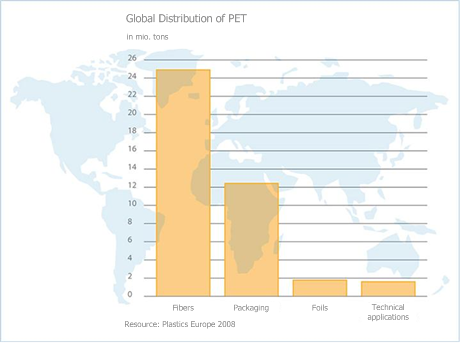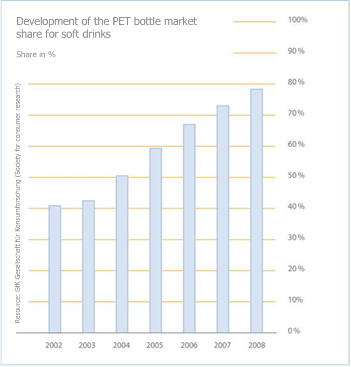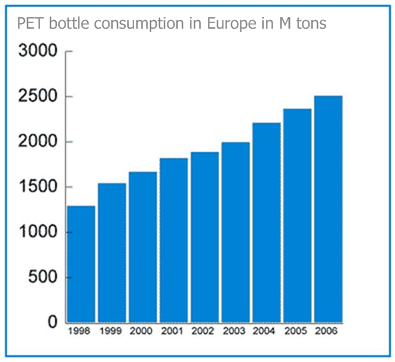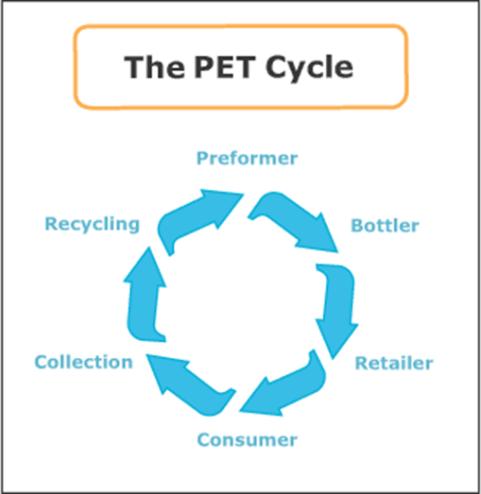Team:TU Darmstadt/Project/Ecology
From 2012.igem.org
Environmental Science
Environmental Engineering is a interdisciplinary field ranging from waste water treatment to disposal of hazmat. The TU Darmstadts iGEM project specifically addresses the area of waste management and waste water technology. The present information on waste management was provided by Kathrin Jager and the wastewater engineering content by Carolin Groß. Their evaluation is primarily focussed on Germany and Europe. This is due to the fact that there is hardly any detailed information available on global PET distribution and the in some cases extreme disparities in the countries laws on genetic engineering.
Waste Management
General information about PET and introduction to the problems from the viewpoint of waste technology
PET products are worldwide, growing in popularity. In 2008, were worldwide about 24 million tons of PET, used in the form of fibers and about 12 million tons of PET packaging. Even more than 1 million tons of films and other technical applications of PET were 2008 worldwide deployment difficulty (see Table 1).
Products made from PET are easily recyclable and can be a versatile recycling center. When PET is however discarded, many problems arise. PET has a very long shelf life in the environment and is very resistant to the influences of the environment. Today, many plastic products are stored in landfills over long periods. When PET is added to a thermal utilization in the combustion process, there are also toxic byproducts caused. The discipline of Environmental Engineering is located in this issue of the waste treatment situation. A genetically modified microorganism, which has the ability to degrade plastics into its components and to metabolize these ingredients and produce high-quality and useful products of it, would be an ideal solution to the disposal problem of PET.
Use of PET and Material Flow Analysis
Over the past few years the percentage of use of PET in Europe rose significantly. Using the example of Germany, you can clearly see how the consumption of PET bottles has developed. The market share of PET bottles for soft drinks in Germany has risen from about 40% in 2002 to almost 80% in 2008.
Moreover, it is possible to see, from the packaging of soft drinks also, that the trend towards increased use of PET packaging, in recent years, also very significantly related to the decrease in the use of other types of packaging such as glass, carton and cans.
| 2004 | 2005 | 2006 | 2007 | 2008 | |
|---|---|---|---|---|---|
| PET | 50.5 | 59.3 | 67.0 | 73.0 | 77.5 |
| Glas | 31.5 | 24.2 | 19.1 | 15.6 | 13.3 |
| Carton | 17.4 | 16.1 | 13.5 | 11.0 | 8.8 |
| Can & others | 0.5 | 0.4 | 0.4 | 0.4 | 0.4 |
| Total | 100 | 100 | 100 | 100 | 100 |
Figure 3: Packaging structures for soft drinks (in%, Germany) (Resource: www.forum-pet.de)
If you look at the percentage values in quantities (t), PET is consumed often in which order of magnitude PET in Europe. Consumption increased by approximately 1,400Mio. tons in 1998, to almost 2,500 million tons in the year 2006.
The PET bottles are collected after use and then sorted by colors, and processed to granulate. These granules are processed and new bottles made from it that are after a quality control back into circulation. In this way, through a long product life cycle, commodities spared.
In 2009 statistics have been created by the Society for Packaging Market Research, that show the amount of plastic waste and its recycling methods. With the material flow analysis software STAN these material flows are presented vividly.
The recycling rate of plastic waste is 48.4%, the energy recovery rate is higher. If a PET bottle leaves the circuit, it will initially be available as granules, flakes, or in bales on the market. Rates vary daily and will vary depending on the form offered.
| Form | Amount (t) | Average Amount per Offer | Minimum Price | Maximum Price | Average |
|---|---|---|---|---|---|
| PET Residue | 19.2 | 6.4 | 0.45 | 0.65 | 0.55 |
| PET Re-granulate | 422 | 70.3 | 0.8 | 0.9 | 0.85 |
| PET Grist | 2624.5 | 87.5 | 0.15 | 0.96 | 0.59 |
| PET Bales | 5908 | 203.7 | 0.02 | 0.52 | 0.29 |
Figure 7: Prices for PET at the market (Data: www.plasticker.de)
The PET will be bought for further processing and it is either processed into fibers, which will then turn into textile products or it is processed as a packaging material, such as egg cartons or even used for car parts or computer parts. If these products have reached the end of its product life, they end up for disposal and this is mainly burned in incinerators. Through the good calorific value, PET waste can be used for the generation of energy. PET bottles can be incinerated at high temperatures, without producing toxic substances. When combustion takes place, with insufficient temperature, it produces toxic byproducts.
| Content | Damage |
|---|---|
| Vaporization (H2O) | Not toxic |
| Carbondioxid (CO2) | Harmfull |
| Carbonmonoxid (CO) | Toxic |
| Soot / Carbon© | Toxic |
| Aromate (Benzol, Naphtalen, Biphenyl, PAK) | Harmful for Health, cancerous, long-term harmfull |
Figure 8: Substances which can be caused by combustion
The actual situation of the disposal of PET
By the requirements of the EU legislation (WFD) and in Germany (new Recycling Act), the producers of products have to be include into the responsibility for the disposal. There is, by this product stewardship, a redemption penalty. Since PET can be used for a long time and is also the recycling returned to the circuit, the disposal is in accordance with the life cycle not in the foreground. Nevertheless, PET may eventually need to be disposed of, and then there is, for the producers in Germany and Europe, the opportunity to sell the PET on the commodities exchange. The withdrawal of the no longer usable PET bottles (returnable) is first in the beverage market. Here ends the responsibility of the consumer. Mortgage drink bottles should be disposed by the consumer, via the Dual System Germany (DSD "The Green Dot”) in the yellow recycling sacks or bins. The bottles of both collections are then transported to a local disposal company and treated there. The bottles are crushed either in a shredding machine or in a scroll compressor. This process simultaneously devalued the PET beverage bottles. Thereafter, the material is brought in sorting. Of these facilities, PET is automatic sorted in foreign materials and recyclable PET. PET separated in colored PET and clear PET. The material is then baled and either returned to the circulation or marketed under the Ordinance. PET has a relatively high calorific value. That makes it interesting for combustion. The cement industry uses material like plastics for the firing of cement kilns. If the industries that use PET to fire, do not or no longer have access to the same extent to PET, it could lead to controversy.
The calorific value of PET is about the calorific value of paper, wood or lignite. But with a calorific value of 4 to 7 kWh / kg there are higher calorific alternatives.
Alternative ways of the recycling of PET (-bottles)
In addition to the main recycling routes of PET, there are now also smaller alternatives. These alternatives exploitations make no significant contribution to the total amount and are mentioned only briefly. China is a large consumer of PET, which is traded on commodity exchanges. There are textiles produced from the PET fibers. This is the most common way for PET fibers, which are no longer returned to the circuit. A group of students from Switzerland has developed a project that brings to aid acquisition of PET bottles, light in the "slums" of poorer Asian cities. Here is a PET bottle is filled with water and a little bleach and the lid sealed. This bottle is then passed through a hole in the ceiling of the hut, attached to the half. By the reflection of light striking on the outside of the bottle, this design brightens the room, how could a 55-watt light bulb.
Disposal of PET, employing the iGEM project of the TU Darmstadt
The microorganism, which is developed in the iGEM project could be made at different points of the PET circuit:
The microorganism may be initially recognized by the collection of PET bottles. Here the percentage of the PET which is no longer used for recycling, is discarded. For this proportion, there are usually fibers produced, which can be used for textiles and other manufactured packaging, such as egg cartons or other plastic parts such as computer parts can be made from this discarded plastic. From this percentage, a part of this amount could be used for the disposal by the microorganism. The second approach would be for the disposal of the products, which were produced from the discarded PET bottles. After the using phase of the products made from PET bottles, they will be disposed, mainly supplied by combustion. At this point, to keep the proportion of harmful combustion less, it is possible to offer the microorganism as a further disposal way and in the future it may replace the complete combustion.
Wastewater Engineering
The General Aspects of Wastewater Engineering
The term wastewater engineering covers all the technologies associated with wastewater, wastewater collection, wastewater discharge and wastewater treatment. The two largest areas of wastewater engineering are related to the water quality and the wastewater and drainage technology.
Treatment plant construction and its purification stages
In a sewage treatment plant, there are various purification steps, which can be in turn to be subdivided into smaller stations. The various stages are generic. Each treatment plant, however, has a special structure. Example:
Purification steps:
Rain relief: If rain and waste water fed into one channel of the wastewater treatment plant (mixed system), then the sewer system usually be relieved by a rain-relief system, through a storm water and / or by an overflow basins.
Rake:
- Wastewater is passed through a screen or sieve drum
- Coarse dirt stuck
- Distinguishes are in fine and coarse screens
Sand / grease trap:
- The sand and grease trap is a sedimentation tank, with the task of removing coarse settleable contaminants from wastewater.
Primary clarifier:
- Suspended solids (faeces, paper, etc.) settles
- Approximately 30 percent of the organic matter can be removed.
Aeration tanks:
- Is in the so-called activated sludge tank by venting the activated sludge (mass of flaky aggregate bacteria) offset the reduced effluent wastewater constituents of the fresh sewage biotically oxidatively.
Clarifier:
- process forms a unit with the aeration tank
- separated by settling of the activated sludge from wastewater
Focus of the wastewater technology at iGEM
Based on the iGEM project we have decided to focus on cleaning techniques in wastewater treatment plants. Among the techniques of wastewater treatment in recent years, in addition to mechanical (rake, sand trap and sedimentation) and biological processes (activated sludge) also chemical processes (precipitation and phosphate) and the use of membrane filters replaced. Through the project, we asked ourselves how we can use the micro-organism in a water treatment plant in the future PET.er.
Since the microorganism works only aerobic would be the best possible use to the aeration tank. For the future, an additional test basin at the example of the treatment plant in Gross-Gerau would be to test the dose, in which you can add the tribes, in which tolerability they stand with other organisms, how they could be dangerous to humans and whether any improvement in water quality occurs.
Additional data WWTP Gross-Gerau
To give a little insight into the actual situation of the treatment plant Gross-Gerau, I run here on a few key figures:
Dry weather feed:
- 5000 m³
Rainy weather feed:
- Up to 15,000 m³
Biological oxygen demand (BOD)
- 550 mg
Chemical oxygen demand (COD)
- 800 mg
C: N: P ratio: The molar ratio of the three elements carbon, nitrogen and phosphorus to one another in an aqueous medium.
- C = carbon
- N = nitrogen
- P = phosphorus
Is the relation of this ratio not held, there is no nitrification.
Based on these data, it may be possible to test the microorganism PETer, in cooperation with the treatment plant Gross-Gerau, in an experiment.
References
[1] Umweltbundesamt: Aufkommen und Verwertung von Verpackungsabfällen in Deutschland im Jahr 2009, 2012
[2] Veolia Umweltservice: Disposal of PET, http://www.pet.veoliaumweltservice.de/de/dienstleistungen/pet-entsorgung.php [14.5.2012]
[3] Liter of Light Switzerland: http://www.literoflightswitzerland.org [12.5.2012]
[4] Welt Online: http://www.welt.de [12.5.2012]
[5] Plasticker: http://www.plasticker.de [12.5.2012]
[6] Studiofroh: http://www.entsorgen.studiofroh.de [12.05.2012]
[7] Forum PET: http://www.forum-pet.de [12.05.2012]
[8] Kalaweit, A. et al.: Handbuch für technisches Produktdesign, Springer 2011
[9] http://www.stadtwerke-gg.org/abwasser.html [11.07.2012]
[10] http://de.wikipedia.org/wiki/Abwassertechnik [11.07.2012]
[11] http://www.schulen.regensburg.de/vmg/unterricht/faecher/biochem/klaeranlage/files/bsb5.htm [16.07.2012]
[12] http://www.schulen.regensburg.de/vmg/unterricht/faecher/biochem/klaeranlage/files/bsb5.htm [14.06.2012]
 "
"



